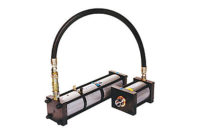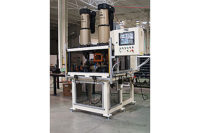Large lithium-ion battery packs are composed of multiple individual cells, each of which contains a pair of compacted lithium-ion powder pellets separated by a collector plate. Composed of proprietary mixtures of lithium and other elements, the pellets must be as identical as possible in terms of size, shape, density and composition. Any variation will adversely affect the chemical and electrical properties of the cell and ultimately shorten the life of the battery.
After they are formed, the pellets must be joined to the collector in a manner that maintains not only their “in process” characteristics, but also creates a perfectly balanced cell with the collector exactly centered between the pellets. Any variation in the cell’s balanced geometry can reduce battery life and overall quality.
Electromechanical Assembly Presses (EMAPs) from Promess Inc. play a key role in helping one battery manufacturer meet those challenges. The battery manufacturer had originally been using hydraulic presses in its operation. However, those presses could not deliver a consistent level of process control for the application.
Cleanliness was also an issue. The lithium powder could not be contaminated by oil or hydraulic fluid. “You can’t achieve nearly the same cleanliness with a hydraulic press as you can with a servo press,” says Glenn Nausley, president of Promess.
Working closely with Promess’ Applications Engineering Group, the battery manufacturer developed a two-step process. First, a 2-ton EMAP preforms the pellets with a force accuracy of ±0.5 percent. Next, four 34-ton EMAPs bond the pellets to the collector, maintaining a positional accuracy of ±25 microns.
“The powder had to be compressed to a very high density,” Nausley explains. “We’re applying 60,000 to 70,000 pounds of force onto a small pellet—and holding that force over time while the material cures.”
The EMAP is a servo-controlled, ballscrew-driven press equipped with a load cell to measure force and an encoder-based servomotor to measure distance. The press can precisely apply force and distance while measuring the functional result and feeding that data back to the control system. Software provides closed-loop control that allows 100 percent in-process differential monitoring.
The force and position feedback signals can also be processed by the press controller to provide a graphic “signature” of each cycle. This signature can be compared to a known good signature to measure the consistency of the pellet-forming process. The signature also offers insight into variations in the characteristics of the raw materials. For example, if the grain size or compaction characteristics of the lithium powder vary from lot to lot, this difference would be evident in the signatures of the pressing operation.
Once gauged and assessed, the process parameters can be modified to accommodate those lot-to-lot variations, or the powder can be modified to match the original specifications. Either way, the ability to monitor the time, force and distance parameters of each press stroke allows the battery maker to effectively “clone” each pellet and ensure each assembly meets specifications.
Big and Beefy
Applications for assembly presses typically require much less than 10 tons of force. In fact, most applications fall in the range of 2,000 to 12,000 pounds. However, a small number of applications—compressing metallic powder for rechargeable batteries, for example—require very high forces, indeed.
To meet that need, many press suppliers now offer standard models with eye-opening force outputs. For instance, Promess offers servo presses with maximum force outputs of 18, 23, 34, 56 and 112 tons. Kistler Instrument Corp. offers servo presses with force outputs of 11, 23 and 34 tons. Schmidt Technology offers a pair of hydropneumatic presses with maximum force outputs of 11 and 25 tons. Both Aries Engineering Co. Inc. and TOX Pressotechnik offer several high-force hydropneumatic presses, the largest of which top out at a whopping 200 tons of force.
Applications for such big presses aren’t necessarily unique. They may simply be larger versions of standard press-fit applications.
“A common application is pressing large pins into flywheels for big transmissions for trucks and tractors,” says Nausley. “That’s a fairly standard press-fit application; it’s just the sheer size of the parts that’s an issue. These pins can be 2 to 3 inches in diameter. The flywheels are 12 inches in diameter. You need a really heavy press-fit, because there’s torque being generated at that joint. The fit needs to be heavy enough that the pin doesn’t slip. Those applications are usually in the [30 to 40 ton] range.”
Other high-force applications include pressing an axle tube into a differential case or forming a metal cup around a ball joint.
Press-fitting multiple parts simultaneously also requires a high-force press—even if each part would require a relatively small amount of force if installed by itself. For example, if 5,000 pounds of force is needed to
press-fit one bushing into a casting, 20,000 pounds of force (4 x 5,000) will be needed to insert all four bushings at the same time.
TOX Pressotechnik recently accommodated an application in which a 100-ton press was used to press-fit eight studs simultaneously. “Instead of hitting the part eight times, you hit it once. A smaller press might run faster, but there’s no substitute for being able to cycle once rather than eight times,” says Troy Waldherr, North American sales manager for TOX.
Although forming or press-fitting multiple parts at once can save time, engineers should approach such applications with caution, advises Michael T. Brieschke, vice president of sales at Aries Engineering. “You want to center the parts around the centerline of the ram to prevent side loads,” he says. “If the parts are, say, 1 inch from each other, that’s not too bad. You can do that with a single ram. But, if they are 6, 10 or 12 inches apart, you might be better off [doing each part individually] and dropping the force down.”
Metal-piercing applications often require high-force presses, particularly if large holes need to be made in thick, hard materials, such as steel, or if more than one hole must be pierced simultaneously.
Press Options
Engineers have three technology options for high-force pressing applications: hydraulic, hydropneumatic and servo.
Hydraulic presses can generate tons of force. Some can produce more than 200 tons of force. However, hydraulic presses are not very energy-efficient, nor are they suitable for applications, such as medical device assembly, that cannot tolerate contamination from hydraulic fluid. Hydraulic presses are also less accurate than other press technologies. Hard stops are often needed to control ram position.
Hydropneumatic presses combine the speed, efficiency and low cost of pneumatic presses with the high output force of hydraulic presses. A hydropneumatic press consists of a hydraulic cylinder, an air-over-oil intensifier and an oil reservoir. At the start of the cycle, the ram approaches the workpiece at high speed, but low force, under
compressed air. Once the ram contacts the workpiece, the intensifier is
automatically energized by a directional control valve. At that point, hydraulic power takes over and the full force of the press is applied. At the end of the cycle, the ram retracts rapidly.
Because it uses compressed air as its primary power source, a hydropneumatic press requires less expensive piping systems and components. There’s no need to fill an oil tank with large quantities of expensive hydraulic fluid. Hydropneumatic presses are also lighter, more compact and more energy efficient than pure hydraulic presses.
TOX Pressotechnik’s hydropneumatic press is unique in that it has a servo-controlled power package. That technology enables engineers to control the position of the ram with an accuracy of ±40 microns, says Waldherr.
Servo presses are the most expensive option for high-force applications, but they’re also the most precise. “Electromechanical presses are used for pin and bearing insertion applications when high precision is needed,” says Nausley. “You can’t get that from pressing to a hard stop.”
Flexibility is another advantage of servo presses. “A lot of high-force applications are low-volume products,” says Nausley. “Lithium-ion batteries come in many different sizes, depending on the product they’re used in. Each size might require a different amount of force. To do that with a hydraulic press, you would have to constantly adjust the hydraulic pressure. With a fully electric press, it’s just a matter of changing the program.”
Whether hydropneumatic or electromechanical, high-force presses are essentially just larger, beefier versions of lower-force models.
Aries Engineering’s 200-ton hydropneumatic press features a cylinder with a 12-inch bore and 1-inch thick walls. The machine’s steel frame is designed to accommodate high forces.
“With high-force applications, we spend a little more time sizing things accordingly,” says Brieschke. “We do a 3D analysis on the frames of all our standard presses, but with the high-force models, each one can be unique as far as the press frame.
“You want to make sure the press frame keeps flexion to a minimum,” he continues. “Flexion in a press will kill a job before it starts. Is the frame capable of handling a 50-ton load? Can it handle a 50-ton load over a five-year period? Sizing the press frame is where we start on high-force applications.”
With servo presses, roller screws tend to displace ballscrews for high-force applications. Depending on the speed requirement of the application, a substantially larger servomotor is not necessary. Rather, the higher output force is generated by a higher-torque gearbox.
Large size and high force do not necessarily translate into less accuracy. Engineers can take advantage of force and distance monitoring technology whether the application calls for 1,000 pounds of force or 100,000 pounds.
“Our large presses are just as accurate in terms of movement as our smaller presses. These monster presses can still move with accuracies of 5 or 10 microns,” says Nausley.
“However, a large press has a much bigger load cell,” he continues. “So, you will lose force measurement accuracy proportionally to the size of the load cell. Force measurement with a 10,000-pound press will be 10 times more accurate than it will with a 100,000-pound press.”
Speed is another trade-off. Big, heavy presses just need a little more time to get the ram moving. The ram on a 1-ton press might weigh 7 pounds. In contrast, the ram on a 100-ton press might weigh 50 pounds. Ram speed for low-force press-fitting applications might be 200 to 300 millimeters per second. For high-force applications, it might be 75 to 100 millimeters per second.
“With large presses, it’s important to think about cycle time and speed requirements,” says Nausley. “With smaller applications, cycle time is generally not an issue. But, larger presses will be slower.”








